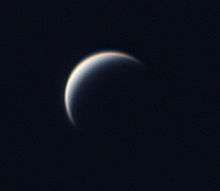Venera 10
 Venera 10 | |
| Mission type | Venus orbiter / lander |
|---|---|
| Operator | Lavochkin |
| COSPAR ID | 1975-054A |
| SATCAT № | 7947 |
| Spacecraft properties | |
| Spacecraft type | 4V-1 No. 661 |
| Manufacturer | Lavochkin |
| Launch mass | 5,033 kg (11,096 lb) |
| BOL mass | 2,230 kg (4,920 lb) |
| Landing mass | 1,560 kg (3,440 lb) |
| Start of mission | |
| Launch date | June 14, 1975, 03:00:31 UTC |
| Rocket | Proton with upper and escape stages |
| Launch site | Baikonur 81/24 |
| Orbital parameters | |
| Reference system | Cytherocentric |
| Eccentricity | 0.8798 |
| Pericytherion | 1,620 kilometers (1,010 mi) |
| Apocytherion | 113,900 kilometers (70,800 mi) |
| Inclination | 29.5° |
| Period | 49.4 hours |
| Revolution number | 71 |
| Venus orbiter | |
| Orbital insertion | October 23, 1975 |
| Venus lander | |
| Spacecraft component | Venera 10 descent craft |
| Landing date | 02:17, October 25, 1975 |
| Landing site | 16°N 291°E / 16°N 291°E (near Beta Regio) |
Venera 10 (Russian: Венера-10 meaning Venus 10), manufacturer's designation: 4V-1 No. 661,[1] was a Soviet unmanned space mission to Venus. It consisted of an orbiter and a lander. It was launched on June 14, 1975 03:00:31 UTC and had a mass of 5033 kg (11096 lb).[2]
Orbiter
The orbiter entered Venus orbit on October 23, 1975. Its mission was to serve as a communications relay for the lander and to explore cloud layers and atmospheric parameters with several instruments and experiments:[3]
- 1.6-2.8 μm IR Spectrometer
- 8-28 μm IR Radiometer
- 352 nm UV Photometer
- 2 Photopolarimeters (335-800 nm)
- 300-800 nm Spectrometer
- Lyman-α H/D Spectrometer
- Bistatic Radar Mapping
- CM, DM Radio Occultations
- Triaxial Magnetometer
- 345-380 nm UV Camera
- 355-445 nm Camera
- 6 Electrostatic Analyzers
- 2 Modulation Ion Traps
- Low-Energy Proton / Alpha detector
- Low-Energy Electron detector
- 3 Semiconductor Counters
- 2 Gas-Discharge Counters
- Cherenkov Detector
The orbiter consisted of a cylinder with two solar panel wings and a high gain parabolic antenna attached to the curved surface. A bell-shaped unit holding propulsion systems was attached to the bottom of the cylinder, and mounted on top was a 2.4 meter sphere which held the landers.
Lander
On October 23, 1975, this spacecraft was separated from the Orbiter, and landing was made with the sun near zenith, at 0517 UT, on October 25. A system of circulating fluid was used to distribute the heat load. This system, plus precooling prior to entry, permitted operation of the spacecraft for 65 min after landing. During descent, heat dissipation and deceleration were accomplished sequentially by protective hemispheric shells, three parachutes, a disk-shaped drag brake, and a compressible, metal, doughnut-shaped, landing cushion.[3]

It landed near the border area between Beta Regio and Hyndla Regio[4] (within a 150 km radius of 15°25′N 291°31′E / 15.42°N 291.51°E), three days after the touchdown of, and 2200 km from Venera 9.[5] Venera 10 measured a surface windspeed of 3.5 m/s. Other measurements included atmospheric pressure at various heights, and temperature, and surface light levels. Venera 10 was the second probe to send back black and white television pictures from the Venusian surface (after Venera 9). Venera 10 photographs showed lava rocks of pancake shape with lava or other weathered rocks in between. Planned 360 degree panoramic pictures could not be taken because, as with Venera 9, one of two camera lens covers failed to come off, limiting pictures to 180 degrees.
The lander communicated with Earth using the Venera 10 orbiter as a communication relay.[2]
Lander Payload:[3]
- Temperature and pressure sensors
- Accelerometer
- Visible / IR photometer - IOV-75
- Backscatter and multi-angle nephelometers - MNV-75
- P-11 Mass spectrometer - MAV-75
- Panoramic telephotometers (2, with lamps)
- Anemometer - ISV-75
- Gamma ray spectrometer - GS-12V
- Gamma ray densitometer - RP-75
- Radio Doppler experiment
See also
References
- ↑ Zak, Anatoly. "Venera-9 and 10". Russianspaceweb.com. Retrieved 14 April 2013.
- 1 2 "NSSDC Master Catalog - Venera 10". NASA National Science Data Center. Retrieved 13 April 2013.
- 1 2 3 Mitchell, Don P. "First Pictures of the Surface of Venus". Retrieved 13 April 2013.
- ↑ Andrew LePage, Venera 9 and 10 to Venus, October 22, 2015 (accessed 19 February 2016)
- ↑ Interplanetary Spacecraft


